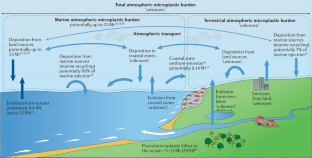最近の研究では、国際的な研究チームが、水域におけるプラスチック汚染の重要な原因として、大気を調査しています。 For a recent study an international research team has investigated the atmosphere as a significant source of plastic pollution in water bodies.
2022-05-10 ドイツ・サステナビリティ研究所(IASS)
<関連情報>
- https://www.iass-potsdam.de/en/news/airborne-micro-and-nanoplastics-pollute-oceans
- https://www.nature.com/articles/s43017-022-00292-x
海洋大気環境におけるマイクロプラスチックとナノプラスチック Microplastics and nanoplastics in the marine-atmosphere environment
Deonie Allen,Steve Allen,Sajjad Abbasi,Alex Baker,Melanie Bergmann,Janice Brahney,Tim Butler,Robert A. Duce,Sabine Eckhardt,Nikolaos Evangeliou,Tim Jickells,Maria Kanakidou,Peter Kershaw,Paolo Laj,Joseph Levermore,Daoji Li,Peter Liss,Kai Liu,Natalie Mahowald,Pere Masque,Dušan Materić,Andrew G. Mayes,Paul McGinnity,Iolanda Osvath,Kimberly A. Prather,Joseph M. Prospero,Laura E. Revell,Sylvia G. Sander,Won Joon Shim,Jonathan Slade,Ariel Stein,Oksana Tarasova & Stephanie Wright
Nature Reviews Earth and Environment Published: 10 May 2022
DOI:https://doi.org/10.1038/s43017-022-00292-x

Abstract
The discovery of atmospheric micro(nano)plastic transport and ocean–atmosphere exchange points to a highly complex marine plastic cycle, with negative implications for human and ecosystem health. Yet, observations are currently limited. In this Perspective, we quantify the processes and fluxes of the marine-atmospheric micro(nano)plastic cycle, with the aim of highlighting the remaining unknowns in atmospheric micro(nano)plastic transport. Between 0.013 and 25 million metric tons per year of micro(nano)plastics are potentially being transported within the marine atmosphere and deposited in the oceans. However, the high uncertainty in these marine-atmospheric fluxes is related to data limitations and a lack of study intercomparability. To address the uncertainties and remaining knowledge gaps in the marine-atmospheric micro(nano)plastic cycle, we propose a future global marine-atmospheric micro(nano)plastic observation strategy, incorporating novel sampling methods and the creation of a comparable, harmonized and global data set. Together with long-term observations and intensive investigations, this strategy will help to define the trends in marine-atmospheric pollution and any responses to future policy and management actions.



